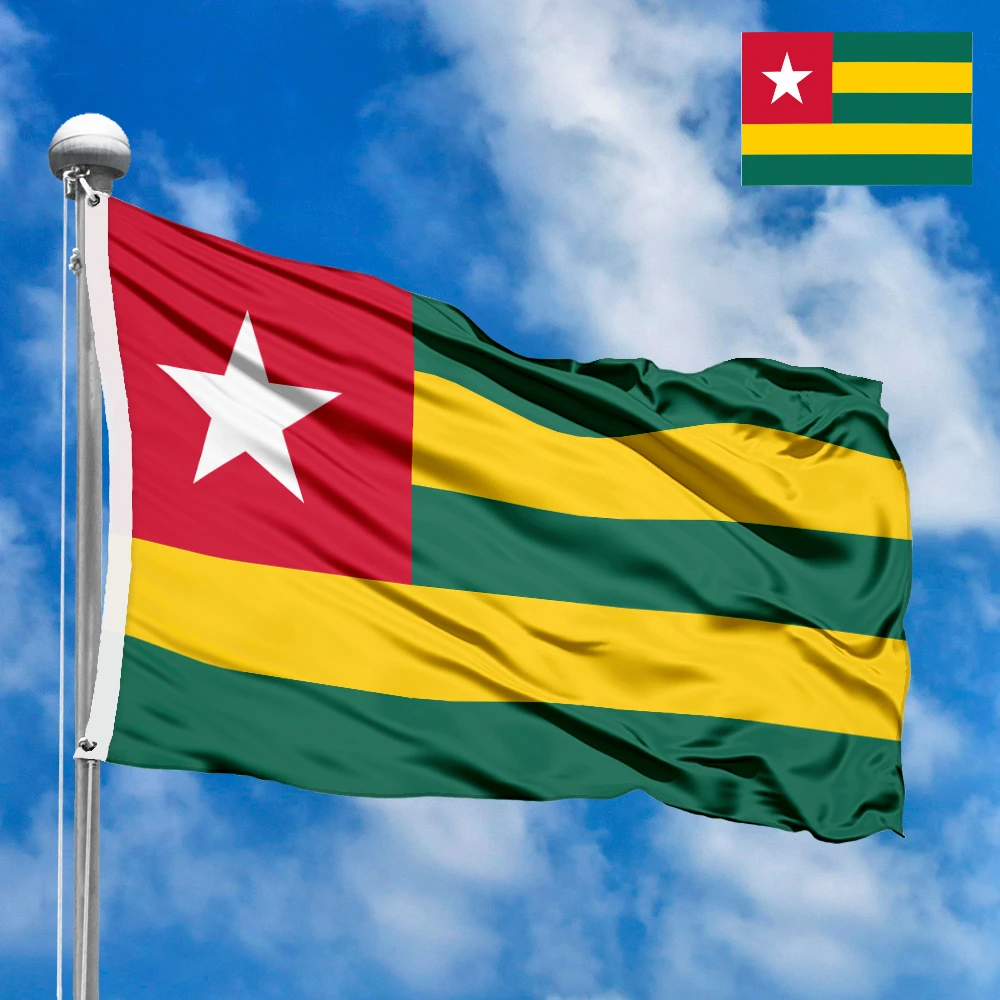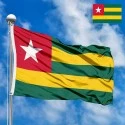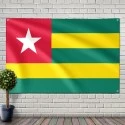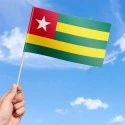The national flag of Togo is a vibrant and meticulously designed emblem that encapsulates the nation's journey from colonial rule to independence, its aspirations for unity, prosperity, and peace, and its unique place within the African continent. Adopted on April 27, 1960, the very day Togo gained independence from France, the flag was designed by Paul Ahyi, a renowned Togolese artist. Its distinctive pattern and rich symbolism make it immediately recognizable and deeply meaningful to the Togolese people.
Design and Symbolism: A Harmony of Ideals
The flag of Togo features five alternating horizontal stripes of green and yellow, with a red square canton (upper hoist quarter) containing a white five-pointed star. This symmetrical and colorful design is not merely aesthetic; each element carries profound national significance:
-
Green Stripes: The flag has three horizontal green stripes. Green is a color universally associated with hope, fertility, and agriculture. For Togo, these stripes symbolize the nation's rich agricultural resources, its abundant forests, and the hope for a prosperous future through the exploitation of its natural wealth. More deeply, green represents the hope that the people of Togo cherish for a bright and flourishing future, built on sustainable development and environmental stewardship. It also evokes the lush landscapes of the country and its reliance on the land.
-
Yellow Stripes: Interspersed with the green are two horizontal yellow stripes. Yellow symbolizes the nation's natural resources, particularly its mineral wealth, and the belief that the hard work and dedication of the Togolese people will lead to prosperity. It also represents the intellectual prowess and wisdom of the nation's citizens, suggesting a bright and enlightened path forward. Yellow signifies a future of abundance and the golden opportunities that lie ahead for the Togolese nation.
-
Red Canton: The red square in the upper hoist (top left) corner of the flag is a powerful symbol of the blood shed by the martyrs and patriots who fought for Togo's independence. It is a poignant reminder of the sacrifices made to achieve sovereignty and the courage and determination of those who resisted colonial rule. Red signifies the spirit of patriotism, the unwavering commitment to national liberation, and the solidarity among all Togolese who strive for a free and dignified existence.
-
White Five-Pointed Star: Positioned centrally within the red canton, the white five-pointed star is perhaps the most potent symbol on the flag. White typically represents peace, dignity, and purity. The star itself is a symbol of unity, liberty, and the aspiration for a bright and guided future. Each of its five points is said to represent one of the five administrative regions of Togo (Maritime, Plateaux, Centrale, Kara, Savanes), symbolizing the unity of all Togolese people regardless of their regional origin. More broadly, it signifies the unique character of Togo as an independent nation, shining brightly among the nations of Africa and the world. It is often interpreted as a beacon of hope, leading the nation towards progress and stability.
Dimensions and Proportions:
The flag of Togo adheres to the Pan-African colors, a common feature among many African flags, yet its unique design proportions set it apart. The official ratio of the flag's width to its length is 3:5. The five horizontal stripes are of equal width. The red canton is a perfect square, with its side length equal to the width of three of the horizontal stripes. The white star is centered within this red square, proportionally sized to be prominent without appearing too large or small. These precise specifications ensure that the flag is consistently reproduced, maintaining its distinct visual identity.
History and Evolution: The Dawn of Independence
Before its independence, Togo underwent various periods of colonial administration. Initially a German protectorate (Togoland) from 1884, it later became a League of Nations mandate territory (and subsequently a UN trust territory) divided between British and French administrations after World War I. The western part eventually merged with Ghana, while the eastern part became the French Togoland. During these periods, various colonial flags were used, predominantly the German flag, and later, the French Tricolour.
As the movement for independence gained momentum in the late 1950s, the need for a distinct national symbol became apparent. The design competition for the new flag was won by Paul Ahyi, a prominent Togolese artist who later became famous for his sculptures and monumental works. Ahyi deliberately incorporated the Pan-African colors (red, yellow, green) but arranged them in a unique pattern that avoided direct resemblance to other African flags while still echoing the spirit of African liberation.
The flag was officially hoisted for the first time on April 27, 1960, marking Togo's independence from France. It was a moment of immense national pride and signified the beginning of a new era for the Togolese people. The flag has remained unchanged since its adoption, a testament to its enduring symbolism and the national consensus around its design. It has consistently represented the nation through various political transitions, reinforcing a sense of continuity and shared national identity.
Regional Context and Pan-Africanism:
Togo is a West African nation, bordered by Ghana to the west, Benin to the east, Burkina Faso to the north, and the Atlantic Ocean to the south. Its flag's use of green, yellow, and red firmly places it within the tradition of Pan-Africanism. These colors, popularized by the flag of Ethiopia (the only African nation to avoid direct colonization during the "Scramble for Africa") and later adopted by the Universal Negro Improvement Association (UNIA) of Marcus Garvey, symbolize African unity, self-determination, and liberation from colonial rule.
While sharing the Pan-African color scheme, Togo's flag stands out due to its distinctive arrangement of stripes and the prominent white star in a red canton. This unique composition allows Togo to express its solidarity with the broader African movement while simultaneously asserting its individual national character. It represents Togo's commitment to the ideals of African solidarity and progress, while also maintaining its unique cultural and historical identity within the diverse tapestry of the continent.
Interesting Facts:
-
Artist-Designed: Unlike many national flags, the Togolese flag was designed by a specific, well-known artist, Paul Ahyi, who was also a sculptor and architect.
-
Pan-African Colors, Unique Arrangement: It cleverly uses the Pan-African colors (red, yellow, green) but arranges them in a unique way (five horizontal stripes, a red square canton with a white star) to stand out from other African flags.
-
Five Stripes, Five Regions: The five horizontal stripes are often linked to the five administrative regions of Togo, symbolizing national unity and cohesion.
-
Independence Day Adoption: The flag was adopted on the very day of independence, symbolizing a fresh start and the nation's self-determination.
-
Balanced Design: The geometric balance of the flag, with the square canton and evenly sized stripes, contributes to its aesthetic appeal and memorability.
-
Beacon of Hope: The white star is widely seen as a beacon of hope and a guide for the nation's future development and stability.
Significance for the Inhabitants: A Banner of Unity, Progress, and Sacrifice
For the people of Togo, the national flag is a source of immense pride and a powerful symbol of their collective identity. It represents their hard-won independence, their resilience in the face of adversity, and their shared aspirations for a better future.
The flag resonates deeply with the history of the nation. The red canton serves as a constant reminder of the sacrifices made by their ancestors to free the land from colonial chains. The green stripes evoke the fertility of their land and the promise of agricultural prosperity, while the yellow signifies the wealth of their resources and the bright future that lies ahead. The white star, unifying the five regions, symbolizes the indivisibility of the Togolese nation and their common destiny.
During national holidays such as Independence Day (April 27th), and other patriotic occasions, the flag is proudly displayed in homes, public buildings, schools, and vehicles across the country. It serves as a unifying force, transcending ethnic and linguistic differences, fostering a sense of national belonging and solidarity among all Togolese citizens. The flag is a constant visual affirmation of Togo's sovereignty, its commitment to peace, and its dedication to progress, inspiring its people to work together for the advancement of their beloved nation. It is a cherished emblem that evokes patriotism and a deep connection to their heritage and future.
In the demonstration images, full-size flags are shown with proportions of 2:3, and hand-held flags with proportions of 1:2.








 Waving flag
Waving flag
 Sizes:
Sizes:
 Round flag
Round flag
 Sizes:
Sizes:
 Rectangular flag 2:3
Rectangular flag 2:3
 Sizes:
Sizes: